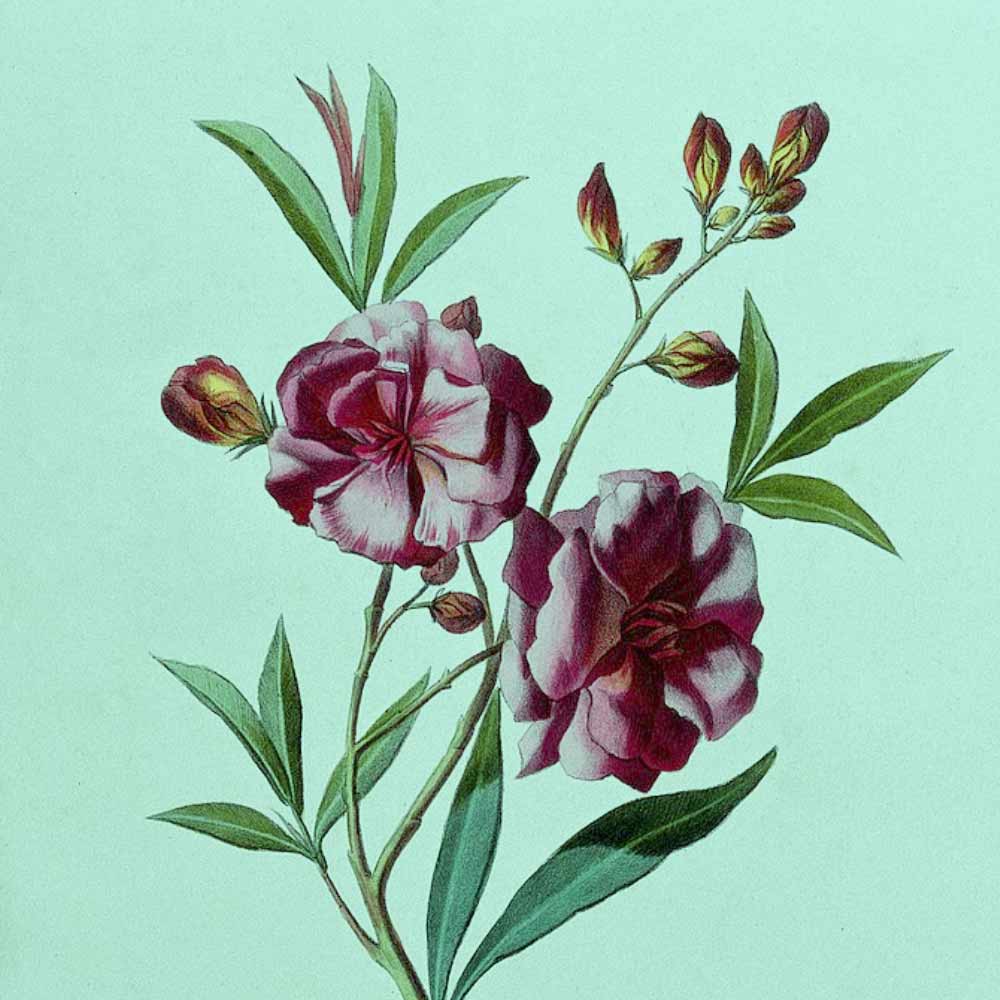We've curated our top five list of poisonous flowers. Read on to learn about these beautiful and deadly specimens and enjoy their stunning illustrations.
Deadly Nightshade (Atropa belladonna)
In 2009, an adult woman ate just six belladonna berries thinking they were blueberries and suffered an extremely severe reaction.

|
Foxglove (Digitalis purpurea)
Foxgloves are magnificent flowers, growing between 1.5 and 2.5 metres tall. Their large purple, pink or white bell-like flowers bloom in summer. They are native to Western Europe and have been introduced to North America. Gardeners should wear gloves or wash their hands after tending to Foxgloves as their flowers, leaves, stems, and seeds are toxic if ingested (and can also irritate sensitive skin). However, it also has medical uses. Digitalis is a drug derived from the dried leaves of the foxglove and it is used to treat heart conditions. Major symptoms of an overdose of digitalis include nausea and vomiting, hyperkalemia, heart arrhythmia or accelerated heartbeats.

|
Hemlock (Conium maculatum)
Conium maculatum aka hemlock is a highly toxic plant originally native to Europe and North Africa but was introduced to Australasia, the Americas and West Asia. It's a hardy species that can reach 1.5 to 3 metres tall and live in several environments. It can be mistaken for other plants, including Queen Anne's Lace, Cow Parsley, wild carrot, parsley, etc. Hemlock has purple-spotted stems and a very distinctive and unpleasant smell when crushed. All parts of the hemlock plant are highly toxic to humans and livestock. The poisonous alkaloids in hemlock damage the respiratory muscles and kidneys. Consuming six to eight leaves can be fatal in adult humans, and hemlock poisoning can also occur by inhaling the smoke from a burning plant, irritation from skin contact or the poison entering the bloodstream through a cut on the skin. It was a means of execution in Ancient Greece, and Greek philosopher Socrates consumed a hemlock potion after being condemned to death.

|
Oleander (Nerium oleander)
 Aconite, monkshood, wolf's-bane (Aconitum)Aconite flowers are typically a deep purple-blue, but can also be white, yellow, or pink, which looks beautiful against the dark green foliage. Aconite roots and tubers contain Aconitine, a strong neurotoxin and cardiotoxin. Poisoning symptoms begin with gastrointestinal upset and pains, followed by numbness and burning in the mouth and stomach, and in severe cases, to the limbs. The poison also affects the heart and is the leading cause of death. In 1524 Pope Clement VII intentionally poisoned prisoners with aconite laced marzipan to test the effects of an antidote. The prisoner who received the antidote survived, and the untreated person died. More recently, in April 2021 president of Kyrgyzstan, Sadyr Japarov, advertised aconite root as a treatment for COVID-19. At least four people required hospital treatment from aconite poisoning. |

|
Interested in Learning More?Get Flowers and Plants via paperback or eBook and access hundreds of beautifully rendered botanical illustrations to use in graphic design projects, wedding invitations, collages and art projects. It is the best reference material available for your botanical illustrations and designs. This 2020 offering from Vault Editions is a brilliantly curated resource of over 400 high-resolution vintage botanical illustrations that will provide you with precisely that. This book features inspiring artwork from acclaimed botanical illustrators and taxonomists such as Hoola van Nooten and J.Pass. This pictorial archive features a diverse range of lush tropical flowers, fruits, palms, ferns, cacti, carnivorous plants and exotic fungi. Also featured are masterfully rendered perennials, roses, classic ornamental garden varietals and more. Download Included: Each book comes with a unique download link providing instant access to all 400+ images featured. These images can be used in art and design projects, or printed and framed to make stunning decorative artworks for home and office. |

|




